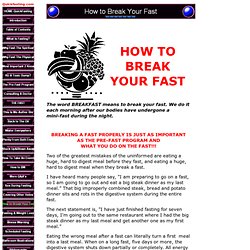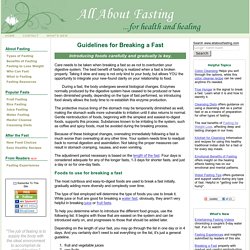

How to Break a Fast and Detect Food Sensitivities – Without Getting Sick. Fall is here and among cleansing communities the shift in seasons is a popular time to fast for health.

Whether attempting a one day water fast, a three day blended fast, a ten day juice fast or even a combination of some sort – breaking a fast properly is crucial to reaping the benefits. I know this because I’ve broken fasts with ease and disease. In the past couple of years I’ve completed over 50 days of water fasting and over 30-days of juice fasting as a part of my lupus recovery. You can read about my 2011 twelve day water fast here. There have been a few times where I was eager to eat too much, or to eat high-fiber foods that are hard to digest too soon. I’ve since learned that preparing mentally to break the fast slowly and with the right food is key. Day 1 – Breaking the Fast: Day 2 – Squash GI Issues: After you’ve enjoyed green squash for a day and your system has gotten used to that – I suggest incorporating pureed or blended (pre-digested) squash such as butternut and acorn. 1.
How to Break Your Fast. The word BREAKFAST means to break your fast.

We do it each morning after our bodies have undergone a mini-fast during the night. Two of the greatest mistakes of the uninformed are eating a huge, hard to digest meal before they fast, and eating a huge, hard to digest meal when they break a fast. I have heard many people say, "I am preparing to go on a fast, so I am going to go out and eat a big steak dinner as my last meal. " That big improperly combined steak, bread and potato dinner sits and rots in the digestive system during the entire fast. The next statement is, "I have just finished fasting for seven days, I'm going out to the same restaurant where I had the big steak dinner as my last meal and get another one as my first meal.
" Eating the wrong meal after a fast can literally turn a first meal into a last meal. The system is not only cleaned of toxins, but it also cleans out the intestinal flora. How you should break your fast depends upon how long you have fasted. Guidelines for Breaking a Fast. Introducing foods carefully and gradually is key.

Care needs to be taken when breaking a fast so as not to overburden your digestive system. The best benefit of fasting is realized when a fast is broken properly. Taking it slow and easy is not only kind to your body, but allows YOU the opportunity to integrate your new-found clarity on your relationship to food. During a fast, the body undergoes several biological changes. Enzymes normally produced by the digestive system have ceased to be produced or have been diminished greatly, depending on the type of fast performed, so introducing food slowly allows the body time to re-establish this enzyme production.
The protective mucus lining of the stomach may be temporarily diminished as well, making the stomach walls more vulnerable to irritation until it also returns to normal. Because of these biological changes, overeating immediately following a fast is much worse than overeating at any other time.